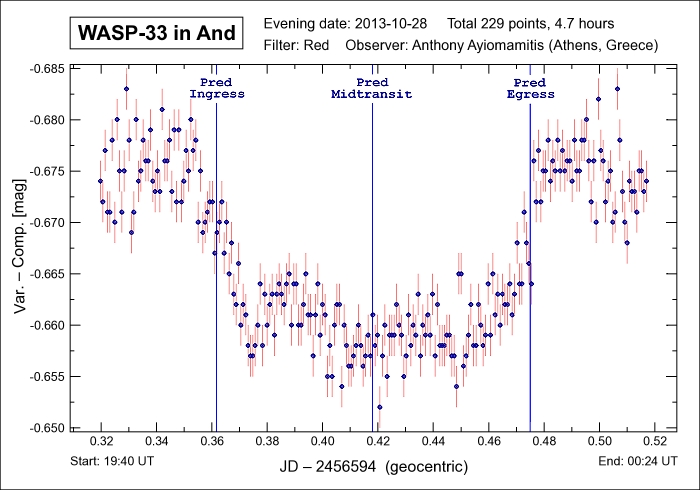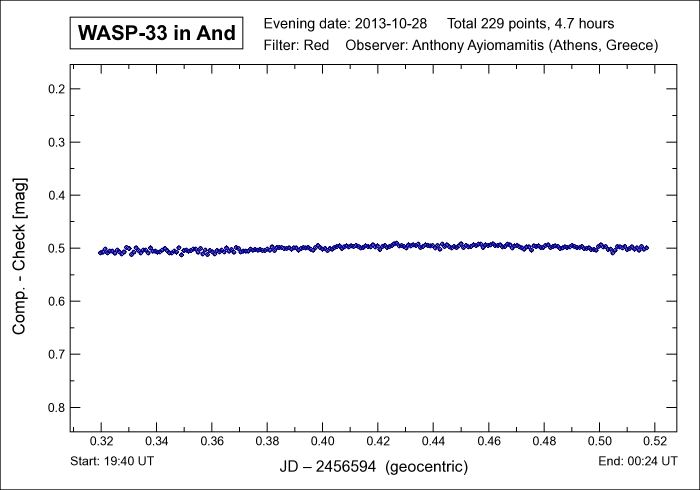
A variable star, as its name suggests, is a star whose magnitude varies intrinsically, in contrast to eclipsing
binaries whose magnitude varies as a result of one star in the binary system eclipsing the other. True variables are
one of five types, namely Mira stars, semiregular stars, cepheids, eruptive variables and, finally, cataclysmic
variables. Minimum to maximum magnitude can range from days to many months with some variables displaying irregular
periods.
A popular method for the study of variable stars, particularly short-term variables, is by the use of the technique
known as "differential photometry". Rather than measure the (variable) magnitude of a variable star on an absolute
scale, measurements are made over time relative to one or more non-variable star(s) and these differences are then
plotted so as to study and illustrate the relative or differential change in magnitude. Due to the very large number
of variables stars, the field of differential photometry represents one of the key fields in astronomy whereby the
amateur astronomer can make a meaningful and long-lasting contribution to both science and astronomy.
More recently, the search for extrasolar planets (925 discovered so far) has identified yet another interesting
application for the practice of differential photometry whereby the minute drops in magnitude of a star hosting an
exoplanet are studied. Further details for the interested party are available
here.
Note: The light curve for exoplanet WASP-33b in Andromeda depicted below is one of the latest
(and larger) transiting exoplanets, having being announced in Apr/2010, and represents the thirty-third discovery by
the WASP (Wide Angle Search for Planets) team. WASP-33b is characterized with a mass less than 4.1 times that of Jupiter
while its radius is equivalent to 1.497 Jupiter radii, thus making this exoplanet one of the larger discoveries to-date.
WASP-33b requires 163 minutes to transit its parent star at a depth of 15.1 mmag or 1.52%.
With an orbital period of only 1.22 days, WASP-33b is also one of the most irradiated exoplanets found so far with an
estimated temperature of 2710° K. WASP-33b is characterized with a retrograde orbit and is one of the few exoplanet
finds so far where such an orbit has been discovered.
The parent star, HD 15082, is an A5 star estimated to have a mass of 1.495 solar masses, a radius equivalent to 1.444
solar radii, a temperature of 7,430° K and to lie at a distance of 378 light-years away with a visual magnitude of 8.3.
Further details regarding WASP-33 and WASP-33b are available in the paper published by the discovery team led
by Collier Cameron et al here.
For a recent paper describing the variable nature of the host star with pulsations suggestive of a delta-Scuti variable,
see the paper by Herrero et al.
Note: The C- and K-stars used for the purposes of the differential photometry measurements
depicted below were SAO 55556 (mag 9.18) and SAO 55557 (mag 9.36) respectively.
|
Parent Star: WASP-33 GSC/SAO/HD Catalog: HD 15082 Constellation: Andromeda RA / Dec: 02h 26m 51.06s / +37° 33' 01.7" Magnitude: 8.3 Distance: 378 light-years Exoplanet: WASP-33b Period: 1.2198669 + 0:0000012 d Transit Duration: 163 mins Transit Depth: 15.1 mmag Minimum Mass: <4.1 MJup Radius: 1.497 RJup Pred Transit Details:
|
 
|
Date: Oct 28-29, 2013 21:40:00 - 02:25:00 UT+2 Location: Athens, Greece Equipment: AP 305/f3.8 Riccardi-Honders AP 1200GTO GEM SBIG ST-10XME SBIG CFW-10 SBIG LRGB filters Integrations:
Temperatures:
Software: CCDSoft V5.00.201 AIP4Win V2.4 Processing: Reduction Differential Photometry |